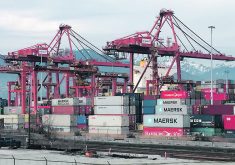Dutch disease is a potential problem for part of Canada, an economist says, but not the part that most people expect.
According to one of the co-authors of an in-depth study about the possibility of Dutch disease affecting Canada, the booming West faces the greatest impacts from the commodity sector boom.
“If there is a Dutch disease phenomenon for some sectors, it’s strongest closer to where the demand is highest,” said University of Saskatchewan agricultural economist Richard Gray.
“What happens when the commodity cycle turns down? Commodity prices don’t tend to stay high for a long time,” Gray said.
Read Also

Farming Smarter receives financial boost from Alberta government for potato research
Farming Smarter near Lethbridge got a boost to its research equipment, thanks to the Alberta government’s increase in funding for research associations.
Dutch disease refers to a phenomenon noticed in the Netherlands in the 1960s and 1970s. A booming resource sector causes the national currency to surge and renders manufacturing exports too expensive to sell to foreign markets.
People in commodity-producing regions see strong economic growth, while people in manufacturing regions see stagnation.
Gray said farmers have struggled to adjust to the phenomenon for a decade, but provincial governments have done little to deal with its possible long-term consequences.
The farm economy has now caught up with the oil economy, so farmers are able to keep up with the energy boom and adapt.
The issue of whether Canada is suffering from Dutch disease has become a hot political question since federal NDP leader Thomas Mulcair charged that some economic problems in Ontario and Quebec are due to the booming western resource economy.
Gray’s study on that question, written with two other economists, has just been published in the Institute for Research on Public Policy.
The study, which looked at the 1992 to 2007 period, found that Canada has suffered a “mild” form of Dutch disease. Less than one-third of Canada’s manufacturing industries have been noticeably hit by the phenomenon. Most manufacturers were able to adjust to a higher currency by increasing productivity.
The IRPP study found that the most low-tech and labour-intensive industries, such as textile production, were hardest hit.
However, it also found that Dutch disease might be a contributory factor, hurting already-declining industries in an era of low-wage global trade.
Dutch disease occurs when booming resource export sales bring more money into an economy, causing resource producers to bid up wages for workers and services. That causes manufacturers to also pay higher wages, but they cannot necessarily raise prices of their goods in the world market.
The problem is exacerbated by the inflow of wealth into the country, which boosts the value of the currency and makes manufactured exports even more expensive for foreign buyers.
Canada’s currency has surged since the mid-2000s but has remained within a trading range for a number of years. The loonie had previously not been tied to the value of oil or commodities, but the relationship has been close since the commodity boom began.
Gray said labour markets tend to be regional, so the situation will have a big impact on the local labour market if a region is generally weak or generally booming.
That means the effects of the western boom will be partially muted for a weak region like Ontario and Quebec. However, the western economy will face much higher wage and price pressure as industries compete for workers.
That’s how Gray ended up working on this area.
Mohammed Shakeri, a PhD student of his at the time, wanted to look at the Dutch disease phenomenon, while Gray had been studying the impact of the booming oil industry on the farming sector.
Oil prices had already begun surging in the early 2000s, causing wages to rise in Alberta and western Saskatchewan, but crop and livestock prices had not yet risen. This was causing farmers to compete with the oil patch for workers, and generally losing, so they aggressively attempted to increase the productivity of their farms.
“You had high oil prices, but agriculture hadn’t taken off,” said Gray.
“It was increasingly difficult for farmers to find reliable labour.”
Farmers bought bigger machinery and more land and tried to mechanize and automate production. That way a single farm family could produce more with the same amount of inputs, he said.
Gray expects farmers will continue to mechanize now that crop and livestock prices have risen. Labour is still expensive and the surge of the currency helps improve productivity.
“The high dollar helps you buy foreign capital equipment,” said Gray.
“If we were at an 80 cent dollar, the $400,000 combine or tractor would be $500,000.”
Gray’s greatest worry about Dutch disease isn’t for Eastern Canada. He is worried about the West, where high commodity prices are creating high wages and big pools of workers, as well as generally higher prices for many goods and services.
Countries with similar resource booms, such as Norway, have extracted money from booming sales and put it into savings. This helps reduce the amount of money in a booming economy and leaves something for coming periods of low commodity prices.
However, western provinces haven’t done this.
“We’re not running up surpluses and adding to a Heritage Fund,” Gray said, referring to Alberta’s former version of an oil-based piggybank.
“We’ve decided that to keep the boom going, we’re not going to tax very much. We’re going to have fairly low royalties, we’re going to keep our income taxes low and make it attractive for people to move here.”
Gray said this could cause problems when the commodity boom ends.
“Often there’s five years of high prices and 15 years of low prices,” said Gray.
“It’s not often 10 and 10. We’ve already had a pretty good run.”
He said the western provinces need to think about how they will adjust if commodity prices drop, but wages remain high and there are no government savings to tide over a period of flat or falling revenues.

















